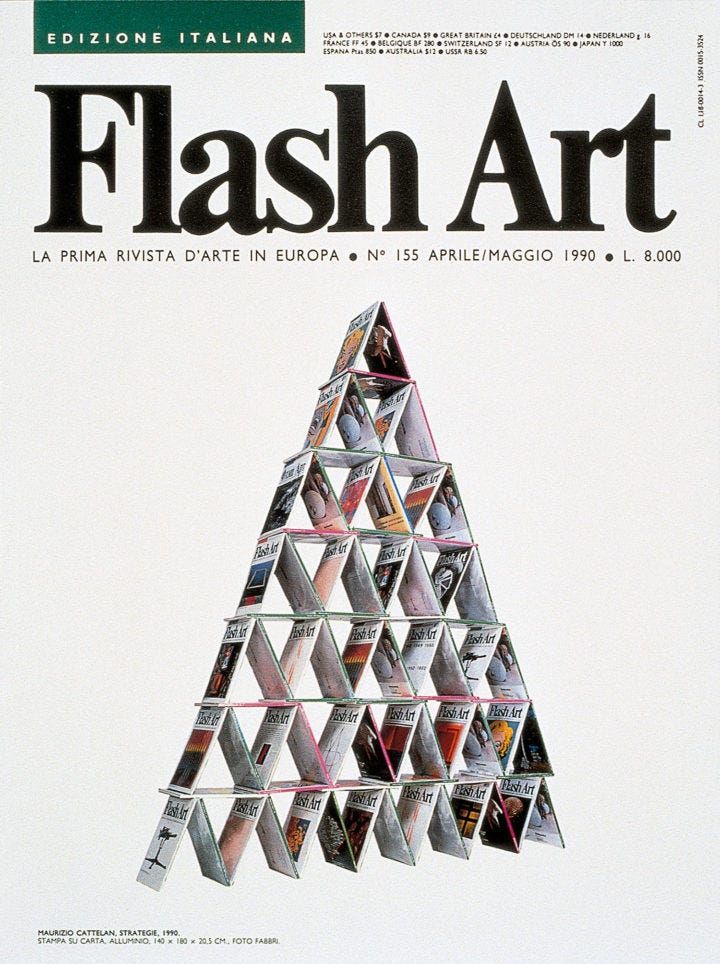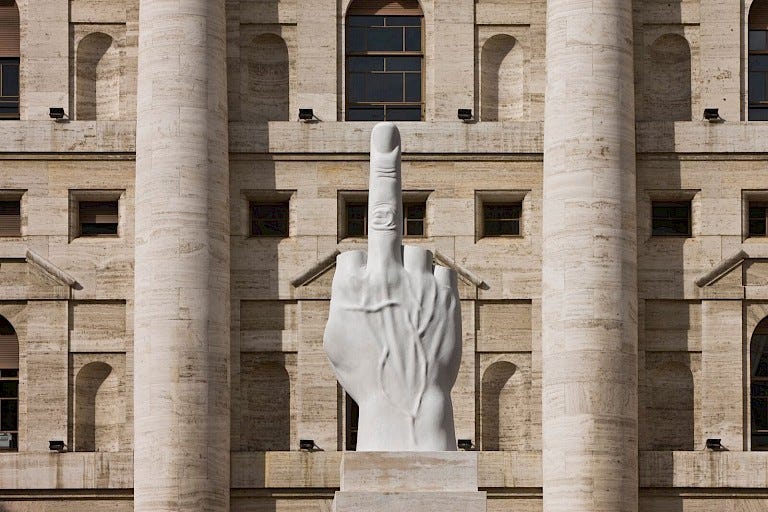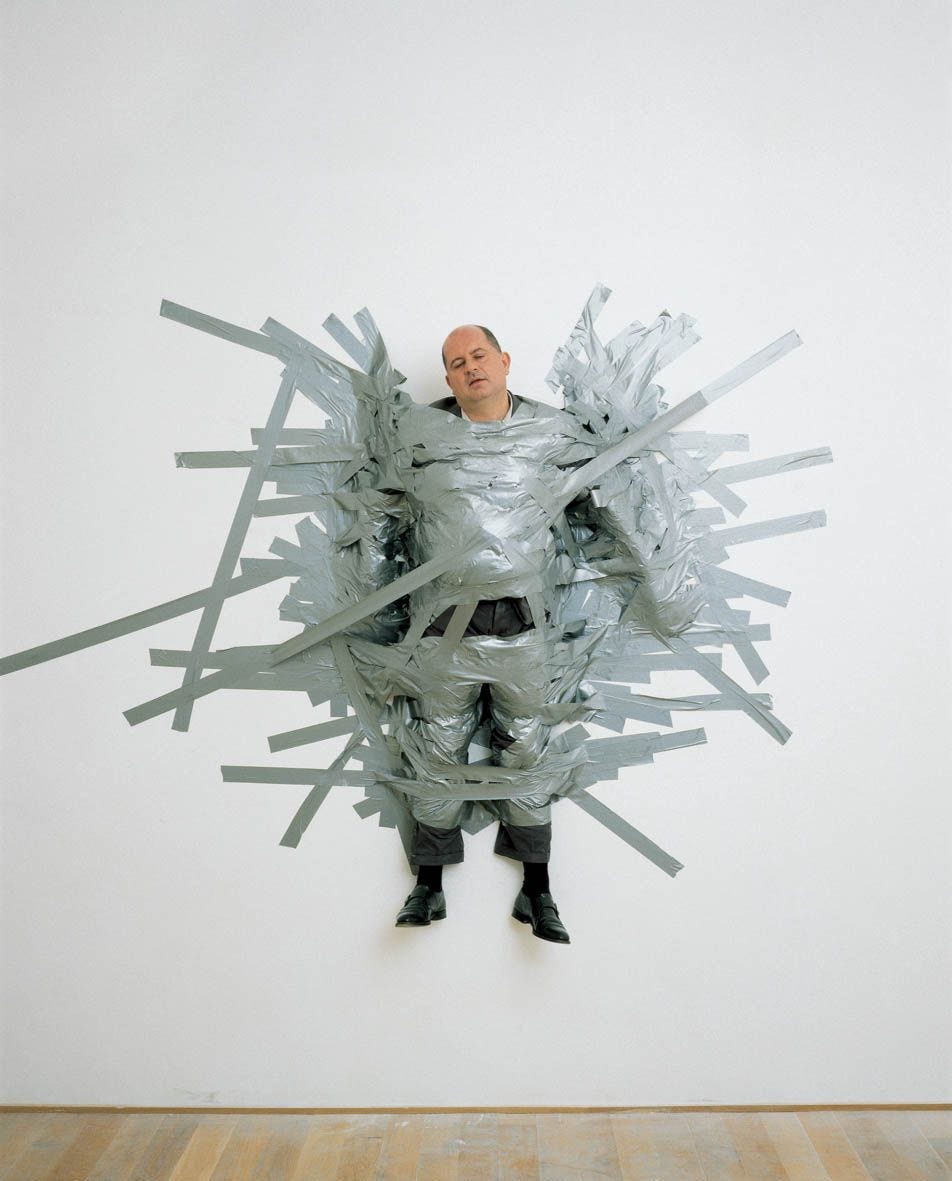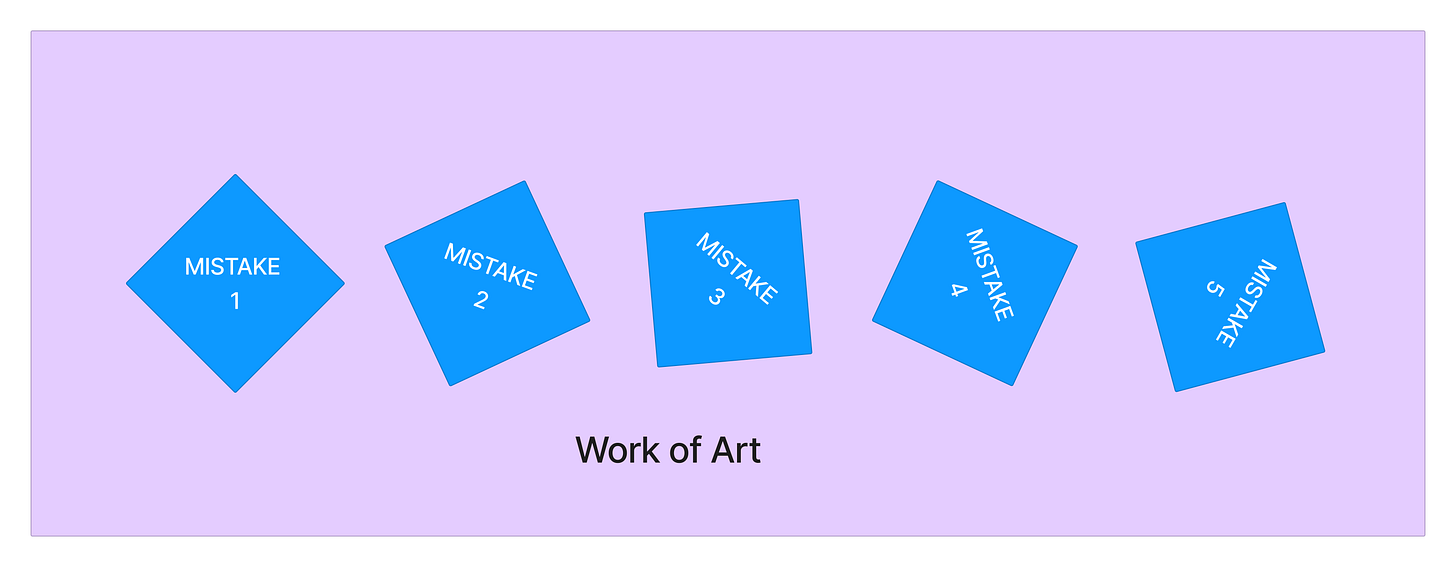Rising from Poverty and School Dropout to a Guggenheim Retrospective
The subversive art and life of Maurizio Cattelan
“Maurizio is an artist that has not dedicated his life to art, he has dedicated his life to success in art, which is different.”
Massimo De Carlo, Italian art dealer
A few months ago, I saw an article about Maurizio Cattelan’s ‘Comedian’, where another artist ate the banana associated with the piece. I burst out laughing when I read it and shared it with a few friends. The piece I am referring to is the banana on the wall that sold at the Art Basel Miami for $120,000. In fact two editions of the piece were sold, and a third edition was donated to the Guggenheim museum. The response from my friends was mixed. Some were offended that the banana was eaten, some thought that anything related to this piece wasn’t worth sharing, others thought it was hilarious.
“…a work’s goal and duty are to reach as many people as possible. Any artist who denies this is a liar.”
Maurizio Cattelan
The fact that there were so many varied responses, is not unusual. Cattelan’s work evokes a visceral response from everyone. It is irksome to people who take themselves too seriously, funny to others, and shocking to some. He is the court jester, the prankster, an opportunist, and one of the most famous artists of our time. He also grew up poor, never went to college or finished school.
A lot of what makes other artists successful doesn’t apply to Cattelan. He also defies some of the other well known researched studies about artists, like people from wealthier backgrounds tend to choose arts as a profession to live off of1. Cattelan’s father was a truck driver and his mother was a cleaner, so art was probably not the top choice for young Cattelan. Being an artist was not a conscious decision, he kind of stumbled into it as a way to avoid a real job. Here is an excerpt from one of his interviews with Nancy Spector, who was the Guggenheim Museum Director at the time.2
….I am not an artist. I really don’t consider myself an artist. I make art, but it’s a job. I fell into this by chance. Someone once told me that it was a very profitable profession, that you could travel a lot and meet a lot of girls. But all of this is false; there is no money, no travel, no girls. Only work. I don’t really mind it, however. In fact, I can’t imagine any other option. There is, at least, a certain amount of respect. This is one profession in which I can be a little bit stupid, and people will say, ‘Oh, you are so stupid; thank you, thank you for being so stupid.’
As Massimo De Carlo, one of Cattelans gallerists, and old friend said, Cattelan works towards being a successful artist and not just any artist. He has been incredibly clear about his fears of failing, or worse, being dismissed and forgotten. Here are some qualities that have led to his success.
1. Hustle
While the hustle culture is synonymous with toxic productivity and burnout, people like Cattelan are intrinsically hustlers. Cattelan moved to Milan in his twenties and was suddenly surrounded by art and design. He was intrigued and fascinated by art and the status that artists could achieve when their work was shown in popular magazines.
To test this out, Cattelan created a pyramid using Flash Art magazines, a popular critical art magazine in Italy. He, then photographed the pyramid and pasted the image on actual Flash Art magazines, and distributed them to stores and art galleries. These perfect looking fakes immediately started to circulate. He called the piece Strategies (1990), a sculpture that stood for a strategy to further his career.
His strategy worked out - In 1994, Cattelan was featured on the cover of Flash Art, and has since been featured on it a total of 11 times, more than any other artist.
Going through the back door in Cattelan’s case makes sense because he had no credibility, no schooling, no art degree, and no connections just yet, but he wanted to get noticed. So he came upon this idea, which certainly got him early attention he was looking for.
“Maurizio wants something from everybody, in that perspective he is surgical and super strategic, it can be friendship, sex, money, a work, a show. He always wants something out of everybody.”
Francesco Bonami, Italian art curator
2. Shock and awe
Cattelan’s art is meant to elicit a reaction, a pretty strong one. Earlier in his career when he was able to procure a show, he (allegedly) became riddled with self doubt and a sense of panic, so he put a ‘Be right back’ sign on the gallery door and took off. The empty gallery and the sign was the art. At another time, riddled with an artists block, he told the police that his work had been stolen. The police report from the incident was hung on the gallery wall as an art work. Another time he stole another artists work from a gallery, and tried to pass it off as his own.
His career is full of examples like this - the pope hit by a meteorite, a lifelike Hitler asking for forgiveness, a dead Pinnochio floating face down in a pool, the L.O.V.E piece outside a the stock exchange in Italy’s financial district in Milan which is a 36’ tall giant middle finger made out of marble, a fake biennial, that was a vacation from him and his artist friends. There are innumerable stories of antics, pranks, tricks, all cleverly planned and realized to create maximum impact.
The one central theme of his work has been to make fun of the art world because it is so opaque and compromised. In doing so, he profits from it. A giant billboard display advertising perfume by an ad agency, instead of putting his own work up for the Venice Biennale is a perfect example of this. It shocked everyone including his curator friend Francesco Bonami who got Cattelan the show as a part of the emerging artists wing for the Venice Biennale. Cattelan fears becoming a one trick pony and forgotten, so having a consistent barrage of provocative pieces has helped keep him top of mind.
..make art to get attention, not to sell, Attention will sell your art not only today but in the future as well.
3. Creating a persona (a personal brand)
Cattelan has crafted his persona very carefully even if it seems like it has been hastily put together. He is the critic, the contrarian, the outsider, the jester. You are either in on the joke or you aren’t. There is an exclusivity factor. The collectors want to be in on the joke, they want to be one saying that they aren’t stuffy old white men (even though a lot of them are old white men), but people who have their finger on the pulse of the art world.
One only has to see the piece with gallerist Massimo de Carlo, where he duct taped Carlo to the gallery wall for two hours under bright lights for a show and called it ‘A Perfect Day’. Carlo fainted and had to be taken to the hospital in an ambulance. Needless to say, the piece garnered a lot of attention.
4. Charisma & Opportunism
Anyone who has interviewed, worked, dated, or collaborated with Cattelan, talks about how charismatic he is, and how he always wants something. In his early days in NYC, Cattelan became close friends with Francesco Bonami, a fellow immigrant from Italy, who was also trying to find his place in the New York art world. Bonami mentions that Cattelan was a figure that entered his life and then he (Bonami) found himself doing things for him (Cattelan). Bonami included Cattelan in the emerging artist wing at the Venice Biennale, a section Bonami was curating at the time. Cattalan did what he always does, played hookie and gave his space to an ad agency to put up a large billboard for a perfume ad.
In Maura Axelrod’s documentary about Cattelan titled Maurizio Cattelan : Be right back, a bunch of curators, critics, gallerists, and collectors weigh in on Cattelan’s personality and how he operates in the art world. Below are some excerpts :
“Contemporary art is about belief, and successful living artists understand that they have to corral belief in themselves. It is really intriguing to think of the way Maurizio builds up relationships.”
Sarah Thornton, writer & sociologist
“Maurizio wants something from everybody, in that perspective he is surgical and super strategic, it can be friendship, sex, money, a work, a show. He always wants something out of everybody.”
Francesco Bonami, Italian art curator
“He has a very clear idea when he is talking to someone what they are capable of doing for them, what they are capable of realizing for him and his work.”
unknown
“He is charming, he is like a magnet, he pulls you in….there is something about Maurizio that gets under your skin.”
Dodie Kazanjian, art critic, Vogue
“Maurizio is a perfect connoisseur of many different aspects of the art world. And as a good artist should do now in this time, is able to manipulate them in order to have better access and better visibility.”
“Maurizio is an artist that has not dedicated his life to art, he has dedicated his life to success in art, which is different.”
Massimo De Carlo, Italian art dealer
Does this mean other artists need to emulate Cattelan’s opportunistic behavior to be successful - No, not in the same way. The lesson to take away here is to look at who can make a difference to your career and move towards getting introduced to those people.
A lot of these strategies can be learned. In my own research, the book ‘The Charisma Myth’ by Olivia Fox Cabane has great practical tips to cultivate charisma.
5. Power through Publicity
Cattelan has always been clear about wanting publicity. His provocative work speaks to that, so does some of his antics, like pasting a photo of his pyramid of Flash Art magazines on the cover of the Flash Art and distributing it. Here is what Marco Senaldi, an art critic, and an editorial intern at Flash Art at the time had to say :
Cattelan had grasped a simple truth that I myself, as critic and curator, had trouble seeing (or perhaps accepting): namely, the strategic function of magazine covers. Though this function may be less relevant today — in our era of online magazines, multiple covers for single issues, free press publications, and so on — in those years the privilege of a cover could secure substantial marketing leverage for the artist who obtained it. Cattelan, as an artist, had already intuited as much; but I, as a critic today, am able to offer a true analysis only in retrospect.3
Here is another excerpt from the Francesco Bonami’s interview with Cattelan about his piece ‘America’ (the 18 karat gold toilet) landing on the cover of the NY Post.
FB : With ‘America’ you ended up on the front page of the New York Post. If you had to choose between selling the work and being on the front page of the Post, what would you have chosen?
MC: The front page for two reasons. First, a work’s goal and duty are to reach as many people as possible. Any artist who denies this is a liar. Second, because it’s like that famous saying from Naples: “Having power is better than fucking.” That’s simply because if you fuck too much, you can’t concentrate on getting power, but if you have power, you can usually find time to fuck as much as you like. That’s the big problem with powerful people. So if I’d chosen to sell the work and not have the front page of the New York Post, I would have given up the work’s purpose. But having the front page I’m sure helped sell the work.
There isn’t much to say more than what Cattalan said in the interview above. His message is clear, make art to get attention, not to sell, Attention will sell your art not only today but in the future as well.
6. Learn, believe, make mistakes
Here is an excerpt from an interview from Autre magazine4. This is a genuinely nice piece for advice from Cattelan to all struggling artists. I am not sure if he is kidding around again though.
SASHA GREY Economics have always dictated art in one way or another, and tend to follow class structures. What advice would you give to young artists that don’t come from the top of the hierarchy who struggle with equal representation within these social structures, especially when many young artists struggle to pay the rent?
MAURIZIO CATTELAN I came late into the art world. I had many jobs that taught me how to survive. I had no experience or professional training. It is all about believing in yourself, working and obsessively learning. Do what pleases you and stick to it. My advice is to be humble and generous with your ideas. There is something to learn from everyone/everything. Go out and see as many shows of all types. Good luck will come to you if you are good-hearted and positive. Lastly, never make the same mistake twice, make it five or six times...just to be certain.
7. Relevance AND Popularity
When Cattelan was trying to make a comeback after his so called retirement, he hadn’t sold anything in years. Then came ‘America’ the gold toilet and he was back. In the interview with his close friend Francesco Bonami, Cattelan talks about why ‘America’ helped him get back on track5.
It (America) belonged to the luxury world but at the same time it was accessible, popular, understandable, not really even for sale. It stirred desire in the head of the elite but maintained its place in people’s imagination.
Cattelan is practical enough to know that he needed something popular and provocative to get back in the scene - he wanted to cater to both the collectors and the museum goer - Relevance AND popularity. Two birds with one stone. They both matter, and artists usually just focus on one or the other. An ending quote or a wrap up from Cattelan.
…it’s important to remember that popularity does not necessarily equate to quality. Art is consumed as any other image, what is missing is the awe of the experience. Masterpieces are those that manage to maintain a balance between being good artworks and being very popular6.
He then goes on to say that producing something just with an intention of selling is not a great place to start in general.
https://news.artnet.com/news/wealthy-people-likely-become-artists-1529341#:~:text=For%20example%2C%20a%20family%20income,if%20they%20made%20just%20%24100%2C000.
https://www.artspace.com/magazine/interviews_features/book_report/i-like-faces-more-than-i-like-artworks-maurizio-cattelan-on-not-being-a-real-artist-54884
https://flash---art.com/article/cattelan-cover-story/
https://autre.love/interviewsmain/tag/maurizio+cattelan
https://gagosian.com/quarterly/2022/02/28/interview-maurizio-cattelan-the-last-judgment/
https://metalmagazine.eu/en/post/interview/maurizio-cattelan












I like this guy! He's very frank about something artists and creators won't admit to themselves, and goes for the straightest line between him and success.
Outstanding piece by Shagun Singh!